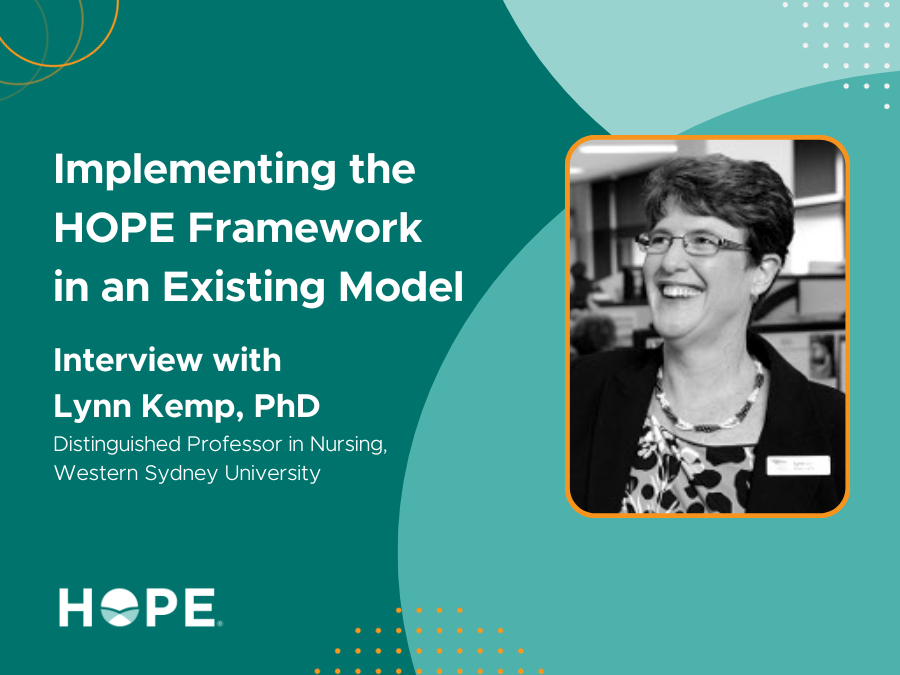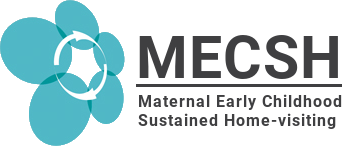
Earlier this fall, we had the pleasure of meeting with Lynn Kemp, PhD, as she stopped at the HOPE National Resource Center at Tufts Medical School. She began her career as a maternal-child nurse, and is now the Distinguished Professor in Nursing at Western Sydney University (WSU), and has successfully developed the Maternal Early Childhood Sustained Home-visiting (MECSH) program at the Transforming early Education And Child Health Research Centre (TeEACH) in WSU. MECSH is an evidence-based program for families who are at risk for poor maternal and child health and development outcomes that is now implemented in Australia, the UK, USA, and South Korea. In September of 2022, WSU and TeEACH became an affiliate of the HOPE National Resource Center. The interview below shares Dr. Kemp’s experiences with integrating the HOPE framework and the Four Building Blocks of HOPE into the MECSH program. She also shares her experience promoting and advocating for the wider shift to the positive throughout her work.
Integrating the HOPE framework into another strength-based model
HOPE and the Four Building Blocks have given this accessible language that we can use to talk to practitioners and policymakers, making our work a lot easier to explain.
Since becoming affiliated with HOPE in September of 2022, how has your work at Western Sydney University changed?
The big contribution that HOPE has made to our work is giving us an accessible language for describing what we do. We have used words like salutogenesis (engaging in health promotion) and words like strengths-based practice, and people say, “What strengths?” and “What does that mean?” But HOPE and the Four Building Blocks have given this accessible language that we can use to talk to practitioners and policymakers, making our work a lot easier to explain.

Research shows that positive childhood experiences (PCEs) drive healthy development and lessen the effects of adverse childhood experiences (ACEs). PCEs can be categorized into the Four Building Blocks of HOPE: relationships, environment, engagement, and emotional growth.
During the development and implementation of Maternal Early Childhood Sustained Home-visiting (MECSH), what were the factors that helped support the inclusion of positive childhood experiences? What were the challenges that you overcame?
In my work as a child health community practitioner, I always knew that it was the positives that made the difference, not focusing on people’s negatives and deficits. So when we developed MECSH, we immediately made the decision that the program would focus on creating positives for families, helping families and children reach their potential. Although we had to target families by assessing risk, that was not how we met them. We met them by asking, “What do you want for your children?”, “What strengths do you have?”, “How can we help you get the most out of your life, your family, your community, your resources, to get the best outcomes for your children?” And what was interesting is that we then have parents telling us things like, “You are the first person who has ever asked me what I wanted, what I wanted to achieve. Most programs come to me saying, ‘What are you doing wrong?’, ‘How do you fix what is going wrong?’ No one ever asked me what I wanted, and that has made all the difference.”
I always knew that it was the positives that made the difference, not focusing on people’s negatives and deficits. So when we developed MECSH, we immediately made the decision that the program would focus on creating positives for families, helping families and children reach their potential.
The biggest challenge, to say it in a phrase is, it is very hard to be saluteogenic (engaging in health promotion and prevention) in a pathogenic (healing existing physical health issues) world when the rest of the world is seeing families for their deficits and you want to see their positives. It is hard to explain what you are doing, and not get dragged back into that negativity. The systems do not support you to stay positive, and that is where HOPE has been so helpful.
The other challenge is, if you actually take a focus on deficits, then there are problems that you can fix, and hence it is very easy to show that you have made a change. But when you are working with people’s strengths, sometimes you do not see the change until further down the track. We have had to deal with organizations saying we are not doing real work, sitting around talking about hopes and dreams. And that has been a real challenge to understand the work that is involved in helping families who have spent their lives being downtrodden and judged by their negatives. Turning them around to seeing their life positively, seeing their children’s future positively, that is work. But it is not work that is valued in a system that just measures what gets fixed.

The Maternal Early Childhood Sustained Home-visiting (MECSH) program is a structured program of sustained nurse home visiting for families at risk of poorer maternal and child health and development outcomes. It was developed as an effective intervention for mothers and families experiencing a range of adversities, including socioeconomic disadvantage, mental health issues, family violence, and previous engagement with the child protection system for themselves or their children. MECSH is a program of Western Sydney University that is now implemented in Australia, the UK, USA, and South Korea.
How does the MECSH program align with the HOPE framework?
MECSH and HOPE go absolutely hand in hand, and the Four Building Blocks of HOPE have given us a lovely set of core elements that the MECSH program needs to be supporting. Supporting relationships, that they are supporting the families to get out of the home and get engaged and supporting emotional growth and looking at safe spaces. And how does that happen in the home? That has been core to MECSH all along. But the language of it is so much easier now with the HOPE framework and we are able to explain and justify the components of MECSH and the necessity for all of those components to be core to the program.
What words of advice do you have for those who want to create similar frameworks and models across any cultures?
My first word of advice would be to start by listening. Listen to families and communities about their hopes and dreams for their children and families. Approach with humility. I do not know what is best for every family. Trust that families know what they are good at, what they need. And then it is quite easy to see where you can help. Start by thinking about what your role is as a provider in terms of supporting family’s access to resources and how you can build their capacity to achieve what they want for their family. And that means you actually approach your work with this co-design idea. It is about a conversation between what I know from my experience and my research and what the community knows from living their lives and how we can bring that together to make a difference.
Listen to families and communities about their hopes and dreams for their children and families. Approach with humility…Trust that families know what they are good at, what they need. And then it is quite easy to see where you can help.
Also, when sitting in isolation, trying to do this work that runs so counter to the dominant medical model, it can be very hard to keep going. Find a supportive environment for yourself if you are going to undertake this kind of work because you will spend more time being frustrated. But the joys are worth it in the end. And that is why it is great to find your tribe. And that is why being with HOPE and the HOPE network has been so helpful, I feel rejuvenated.
Interview edited for brevity and clarity.




